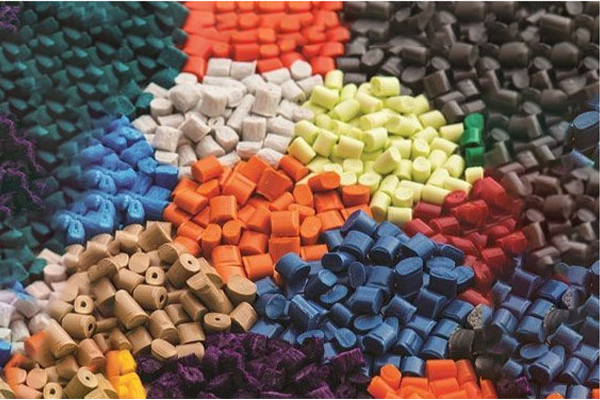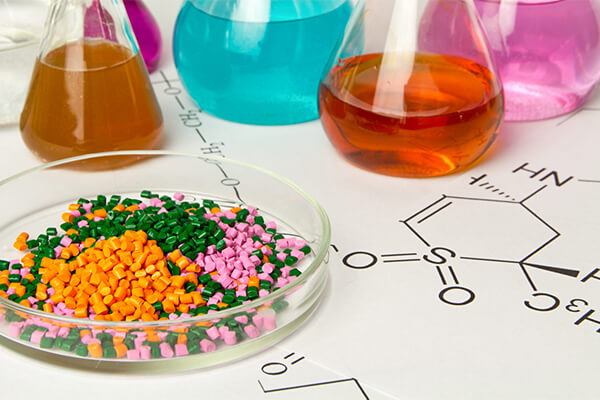Injection Moulding Materials
We always use various kinds of materials in the process of injection moulding, for the desired results of finished plastic parts or products.
Injection moulding materials usually involve thermoplastics, thermosetting plastics, elastomers and rubber materials and additives and fillers. According to the different properties of injection moulding materials, costs, production volume, specific applications and etc., we need to choose the desired injection moulding materials.
When we consider the selection of injection moulding materials, let’s get to know the below contents: the properties of injection moulding materials, and what are different injection moulding materials suitable for?
At Sungplastic, you will find what you need for your projects.

Nylon (PA)
Nylon, also known as Polyamide (PA), is commonly utilized for the production of robust mechanical components such as bushings, gears, and bearings. Its widespread use in automotive applications is attributed to its toughness, weight reduction benefits, and lower production costs compared to metal counterparts. However, it should be noted that nylon has a tendency to absorb water, making it less suitable for marine applications.
Acrylic (PMMA)
Acrylic, or Polymethyl Methacrylate (PMMA), is a versatile material employed for manufacturing transparent parts like windows, view screens, and various lighting equipment. It serves as a glass alternative due to its high tensile strength, resistance to weathering and scratches, and excellent compatibility with dyes and colorants, allowing for a wide range of aesthetic effects. Furthermore, acrylic is odorless, tasteless, and free from Bisphenol A (BPA), making it considered safe for food storage.
Polycarbonate (PC)
Polycarbonate (PC) is another transparent injection moulding materials known for its exceptional optical properties and durability. This amorphous thermoplastic material enables precise dimensional control during the molding process, thanks to its predictable and uniform mold shrinkage. Polycarbonate is typically chosen when a higher level of strength is required compared to acrylic. However, it should be noted that for optically clear plastic parts, a highly polished mold tool is necessary, which may involve the use of costlier, higher-grade stainless steel.
Polyoxymethylene (POM)
Polyoxymethylene (POM), commonly referred to as acetal resin, is an engineering thermoplastic material used for the production of mechanical and automotive parts that were traditionally made from metal. POM exhibits high strength, toughness, and rigidity, making it well-suited for gears, fasteners, knife handles, and ball bearings. It offers excellent resistance to solvents such as alcohols, gasoline, detergents, and motor oils but should not be exposed to hydrochloric acid and nitric acid.
Polystyrene (PS)
Polystyrene (PS) is one of commonly used injection moulding materials available in two types: High Impact Polystyrene (HIPS) and General Purpose Polystyrene (GPPS). GPPS is transparent, while HIPS is opaque. High Impact Polystyrene is frequently employed for manufacturing hard cases for toolboxes and power tool bodies. While PS is known for its toughness and durability, it is not environmentally friendly due to its limited biodegradability.
Acrylonitrile Butadiene Styrene (ABS)
ABS resin is an opaque thermoplastic polymer widely used in engineering-grade applications. ABS offers numerous advantages, including toughness, dimensional stability, impact and scratch resistance, and high break resistance. Its low melting temperature facilitates easy molding, making it suitable for producing electronic parts such as phone adapters, keyboard keys, and wall socket plastic guards. ABS also acts as a good insulator, ensuring electrical safety and minimal fume emission in the event of fire.
Polypropylene (PP)
Polypropylene (PP) is one of widely utilized thermoplastic injection moulding materials in the food storage and packaging industry due to its excellent chemical resistance that prevents chemical interactions with food products. PP can withstand hot water washing without degradation and possesses high chemical and moisture resistance. It exhibits remarkable impact strength, elasticity, and toughness. Designers appreciate that PP is easily recyclable and can be utilized to create live hinges capable of enduring frequent bending without tearing.
Polyethylene (PE)
Polyethylene (PE) is a lightweight thermoplastic molding material known for its high chemical resistance, elasticity, and electrical insulating properties. Although it is not particularly strong or hard, it is cost-effective. PE can be found in various consumer plastic parts, including milk bottles, medicine and detergent containers, plastic bags, and trash cans. It is also the most common injection molding resin used for making toys due to its non-toxic nature and ability to withstand rough handling.
Thermoplastic Polyurethane (TPU)
Thermoplastic Polyurethane (TPU) is a soft and elastic material possessing excellent tensile and tear strength, making it suitable for parts requiring rubber-like elasticity. Although TPU is relatively more expensive than other resins, it finds indispensable use in applications such as protective wire and cable sheaths where no suitable alternative exists. Additionally, TPU enhances grip for products that require secure handling.
Thermoplastic Rubber (TPR)
Thermoplastic Rubber (TPR), also known as thermoplastic elastomer (TPE), is a blend of plastic and rubber that can be easily used in the injection molding process. TPR exhibits outstanding chemical and weather resistance, as well as high impact strength. It finds application in various fluid dispensers, flexible hoses, catheters, and other environments involving different liquids, including acids. This recyclable material is commonly used in medical catheters, suspension bushings, headphone cables, and more.
Polyurethane (PU)
Polyurethane is a diverse thermoplastic material known for its exceptional flexibility, durability, and resistance to abrasion. It comes in various forms, including rigid and foam, making it suitable for applications ranging from automotive parts and industrial seals to cushioning in furniture and footwear.
Polyvinyl Chloride (PVC)
PVC is a versatile plastic often used in injection molding for items like pipes, cable insulation, and vinyl records. It can be formulated as rigid or flexible PVC, depending on the desired application. Rigid PVC is used for items like plumbing fittings, while flexible PVC is found in products like inflatable structures and medical tubing.
Polyethylene Terephthalate (PET)
PET is a thermoplastic commonly used for making bottles, containers, and packaging materials due to its clarity, strength, and recyclability. It can be molded into various shapes and sizes for beverage bottles, food containers, and other consumer products.
Polyphenylene Sulfide (PPS)
PPS is a high-performance engineering plastic known for its excellent chemical resistance and heat resistance. It’s often used in applications where resistance to harsh chemicals and high temperatures is essential, such as automotive parts, electrical components, and industrial equipment.
Polyimide (PI)
Polyimide is an extremely heat-resistant material often used in aerospace and electronics for its ability to withstand extreme temperatures without degradation. It’s suitable for applications like electronic components, insulating films, and high-temperature gaskets.
Polyethylene Naphthalate (PEN)
PEN is a thermoplastic resin with excellent clarity, barrier properties, and chemical resistance. It’s used in the production of food packaging, optical films, and high-performance films for various industrial applications.
Polyetheretherketone (PEEK)
PEEK is a high-performance thermoplastic known for its exceptional mechanical properties, chemical resistance, and high-temperature stability. It’s used in aerospace, automotive, medical, and electronics industries for components that require high-performance materials.
Liquid Silicone Rubber (LSR)
LSR is a two-part, platinum-cured silicone rubber material used in injection molding to create flexible, heat-resistant, and durable parts. It’s commonly employed in medical devices, automotive components, and consumer goods.
Nitrile Butadiene Rubber (NBR)
NBR is a synthetic rubber material used for injection molding in applications where oil and fuel resistance are crucial, such as automotive gaskets, seals, and hoses.
Polymethylpentene (PMP or TPX)
PMP is a transparent thermoplastic known for its low density, high heat resistance, and excellent electrical insulating properties. It is used in optical applications, lab equipment, and food packaging.
Thermosetting Plastics
Thermosetting plastics differ from thermoplastics in that they undergo irreversible curing when exposed to heat, making them heat-resistant and dimensionally stable.
Such as:
- Phenolic Resin (Phenolics)
Exceptional heat resistance, electrical insulation, and flame resistance.
Found in electrical components, appliance handles, and automotive parts. - Epoxy Resin (Epoxies)
High mechanical strength, chemical resistance, and excellent adhesion properties.
Common in aerospace, marine, and automotive industries for composites and coatings.
Elastomers and Rubber Materials
Elastomers are rubber-like materials known for their elasticity and resilience. Here, we provide elastomers and commonly used rubber materials in injection molding.
Such as:
- Silicone Rubber
Excellent temperature resistance, flexibility, and biocompatibility.
Applications: Used in medical devices, gaskets, seals, and kitchenware. - Ethylene Propylene Diene Monomer (EPDM)
Superior weather resistance, ozone resistance, and electrical insulation.
Applications: Found in automotive weatherstripping, roofing, and outdoor seals.
Additives and Fillers
Additives and fillers play a pivotal role in fine-tuning the properties of injection moulding materials.
Additives
Additives can enhance material stability, UV resistance, and aesthetics.
Applications: UV stabilizers for outdoor products, colorants for consumer goods.
- StabilizersThese additives help protect plastic injection moulding materials from degradation due to factors such as heat, light (UV stabilizers), and oxidation. Common types include UV stabilizers, heat stabilizers, and antioxidants.
- Colorants
Colorants are added to plastics to achieve specific colors or to make them more visually appealing. Pigments and dyes are commonly used as colorants. - Plasticizers
Plasticizers are used to make plastics more flexible and less brittle. They are often found in PVC products, such as vinyl flooring and flexible hoses. - Flame Retardants
These additives reduce the flammability of plastic injection moulding materials and can be crucial for applications where fire safety is a concern. Examples include halogenated flame retardants and phosphorus-based flame retardants. - Antistatic Agents
Antistatic additives are used to reduce or eliminate static electricity buildup on the surface of plastics, which can attract dust and cause other issues. They are often used in electronic and packaging applications. - Impact Modifiers
Impact modifiers enhance the toughness and impact resistance of plastics. They are commonly used in applications where the injection moulding materials may experience sudden forces or impacts. - Biocides
Biocidal additives help prevent the growth of microorganisms, such as bacteria and fungi, on the surface of plastics. They are used in applications like healthcare and food packaging.
Fillers
Fillers reinforce injection moulding materials, improve stiffness, and reduce shrinkage.
Applications: Glass fiber-reinforced plastics for automotive parts, nanoparticle-filled materials for electronics.
- Glass Fibers
Glass fibers are commonly added to plastics to reinforce them, making the material stiffer, stronger, and more dimensionally stable. This is often used in automotive and structural applications. - Mineral Fillers
Fillers like talc, calcium carbonate, and mica can be added to improve stiffness, reduce shrinkage, and enhance flame resistance in plastics. - Nanoparticles
Nanoparticles, such as nanoclays and carbon nanotubes, are used to enhance properties like mechanical strength, barrier properties, and electrical conductivity in plastics. - Fibers (Natural or Synthetic)
Natural fibers (e.g., hemp, jute) or synthetic fibers (e.g., aramid) can be used as fillers to enhance mechanical properties or provide a unique appearance. - Foaming Agents
Foaming agents are used to create foam structures within plastics, reducing material density and improving insulation properties. This is commonly seen in the production of foam packaging materials.
If you do not know more about the main injection moulding materials and auxiliary materials, you can consult us and we will provide you with the most effective suggestions combined with the key of cost-effectiveness, good performance, and durability.
We are ready for your injection moulding projects!
Get a free quote and design analysis today.
We’ll reply to you within 6 working hours.
We respect your privacy.
+86 139 2927 4777 (WhatsApp, Wechat)

